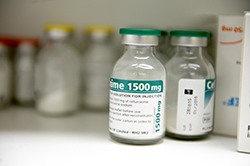Parkinson's Disease
Medications for Idiopathic Parkinson's Disease
 The main aim is to restore dopamine levels in the basal ganglia.
The main aim is to restore dopamine levels in the basal ganglia.
The core treatment is therefore with Levodopa (L-dopa) which gets converted to dopamine.
This is given with dopa-decarboxylase [DDC] to prevent peripheral conversion to dopamine.
This comes as Sinemet (co-careldopa) or Madopar (co-beneldopa)
This is given with dopa-decarboxylase [DDC] to prevent peripheral conversion to dopamine.
This comes as Sinemet (co-careldopa) or Madopar (co-beneldopa)
The duration of action of L-dopa can be extended by catechol-O-methyl-transferase inhibitors (COMT-inhibitors) which reduce the breakdown of L-dopa. These exist as entacapone and tolcapone. They only work with L-dopa, and have no action themselves. Stalevo is a convenient combination of Sinemet and entacapone.
Once formed and released in the basal ganglia, dopamine is broken down by monoamine oxidase B, in the synaptic cleft. MAO-B inhibitors like selegiline and rasagiline reduce this breakdown and increase dopamine levels.
Another approach is to act directly post-synaptically on dopamine receptors.
The dopamine agonists are generally less potent, with some troublesome s/e (impulse control disorders, hallucinations) but may slow progression to "on/off" fluctuations. They are pramipexole, ropinirole, rotigitine (and cabergoline, which is seldom started now but still prescribed).
Amantadine is occasionally used in bad dyskinesia, and works to decrease reuptake of dopamine (and as an NMDA antagonist).
Other treatments, aimed at restoring the imbalance within the basal ganglia, are anticholinergics and neurosurgery. Novel techniques like stem cell transplant and nerve growth factor infusion remain experimental.
Parkinson's UK has a display of all the different medicines by class and dose and tablet form.
Back to Medications & NBM Guidelines

